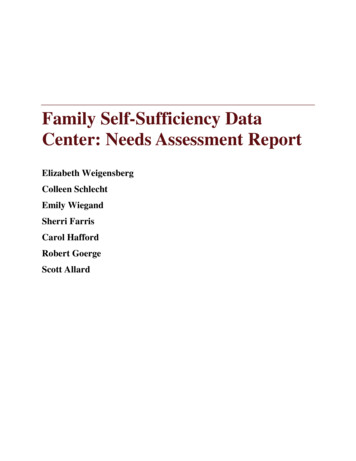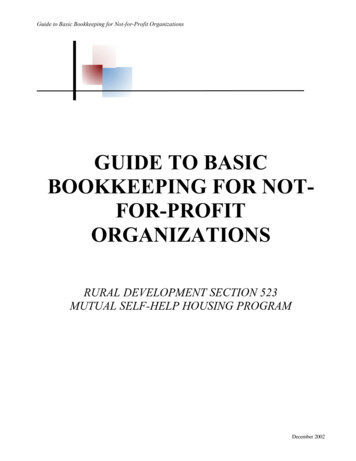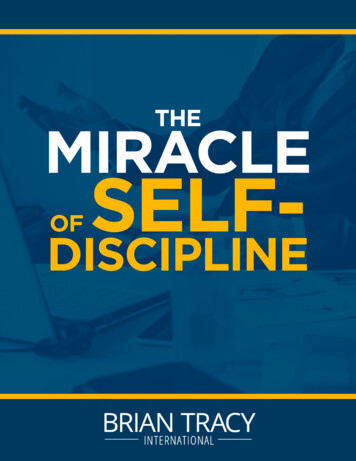
Transcription
BuildingSelf-SufficiencyUnderstanding the effects ofpoverty and how three Greenvillenonprofit organizations areaccompanying people on thejourney to stabilitySally Morris Cote, Ph.D.A publication of The Riley Institute at Furman University
Leadership, Knowledge, Impact.The Riley Institute advances social and economic progress in South Carolina and beyond bycreating knowledge through community solutions-focused research, building leadership for adiverse society, hosting expert speakers to broaden perspectives on critical issues, andsupporting public education.The Institute’s Community Solutions Research Group promotes evidence-informed practicesand policies and supports entities that serve children and families across the state. The group’scommitment to equitable outcomes for all South Carolinians underlies all of its work. In thisspirit, it provides external research and evaluation services, serves as an evaluation partner,delivers strategic learning opportunities, and facilitates educational opportunities andworkshops for nonprofit professionals.To learn more about the Riley Institute’s research work, visit riley.furman.edu or contactResearch Director Dr. Brooke Culclasure at brooke.culclasure@furman.edu.Suggested Citation: Cote, Sally Morris. (2021). Building Self-Sufficiency: Understanding the Effects of Poverty and HowThree Greenville Nonprofit Organizations are Accompanying People on the Journey to Stability. Greenville, SC: TheRiley Institute at Furman University.
FundersThis report was generously supported by the Graham Foundation, a private family foundationbased in Greenville, South Carolina, that supports select organizations throughout the southeastand with an emphasis on long-term capacity building support.AcknowledgmentsThe Riley Institute would like to thank Eleanor Dunlap, Chief Impact Officer at the GrahamFoundation, for inspiring and supporting this work. Eleanor is responsible for bringing togetherthe Center for Community Services (CCS), Foothills Family Resources (FFR), and UnitedMinistries (UM) as the Integrated Services Alliance and connecting them to the Riley Institute.The author extends her appreciation to the staff of the Riley Institute who supported her workwith the Integrated Services Alliance by attending countless meetings, acting as a soundingboard for ideas, and thoughtfully reviewing this brief and others since this project began in 2019,specifically: Dr. Brooke Culclasure, Research Director; Kate Stevens, Research Associate; Dr.Delia Allen, former Research Associate; Dr. Tracy Waters, Assistant Research Director; and KatieQuine, Marketing and Communications Manager.Most importantly, deepest thanks go to the directors and staff of CCS, FFR, and UM, specifically:Andrew Ross, Executive Director of CCS; David Bolton, former Executive Director of FFR andcurrent Director of Workforce Initiatives at the Community Foundation of Greater Greensboro;Marilyn Neves, Executive Director of FFR; and Ethan Friddle, Director of Programs andOperations at UM. They welcomed me into their organizations and engaged in the painstakingwork of educating me on how they functioned and what challenges they faced. This brief wouldnot have been possible without their willingness to dive into the research and evidence,question program logic, and be candid in assessments of their successes and failures. Theirdesire to never stop searching for ways to better serve the community is an inspiration.
Integrated Services PartnersFounded in 1970 to meet the crisis needs of Greenville Countyresidents, United Ministries (UM) has evolved to focus ondeveloping the potential each family possesses to become selfsufficient—and even to thrive. While short-term needscontinue to be met by direct financial aid, homeless day shelterservices, and a congregational shelter network for homelessfamilies, the majority of the agency’s resources are invested inpeople working toward long-term education, employment,housing, and financial wellness goals. In the agency’s Striving toThrive program, staff partner with individuals to identifypersonal strengths and goals and to develop and implementaction plans to help families thrive.Foothills Family Resources (FFR) is a 35-year-old nonprofitorganization located in Slater, South Carolina. The mission ofFFR is to improve the quality of life in Northern GreenvilleCounty by providing residents a gateway to comprehensiveservices, programs, and resources that support, educate, andempower. FFR focuses stabilization services toward individualsexperiencing poverty and/or in need. Services include, but arenot limited to: SNAP, WIC, Medicaid application assistance,Food Pantry, Rent/Utility Assistance, mental health support,GED training, and vocational rehabilitation counseling. In theCenter for Working Families, FFR provides one-on-one, shortterm coaching and soft skill development.The Center for Community Services (CCS) was founded in 1997and serves as the primary nonprofit in Southern GreenvilleCounty that engages the challenges of systemic poverty. CCSunites several area nonprofits under one banner, providing ahub in the Golden Strip where people who face challengingfinancial circumstances can come for both immediateassistance and long-term help in breaking the cycle of poverty.CCS addresses four core areas that profoundly impact a family’sfinancial situation: education, employment, financial stability,and school readiness for children. Staff treat each person theyencounter with dignity and work to set the stage for clientsuccess in improving their own situation.
Table of Contentsvi Executive Summary1 The Impact of Poverty1Diminished Self-Regulation2Diminished Self-Efficacy3 Self-Sufficiency: More than Financial Security4 An Integrated Approach5How Does Integrated Services Aid Individuals Seeking Self-Sufficiency?6Integrated Services in Greenville County7 A Relational Approach8Coaching for Self-Sufficiency11 Measuring Self-Sufficiency12The Importance of Measuring Progress in Addition to Completion12Measuring Psychological Self-Sufficiency14 Conclusion15 Glossary16 Appendix A17 Appendix B18 EndnotesIT’S TIME TO RETHINK HOW POVERTY IMPACTS INDIVIDUALS AND WHAT IT REALLY TAKES TO ACHIEVE SELF-SUFFICIENCY.
Executive SummaryAlong with much of the southern United States, Greenville County ranks among the hardest areas inwhich to achieve upward economic mobility. A child raised in the bottom fifth of the incomedistribution in Greenville County has less than a 5% chance of moving into the top fifth as an adult.1The purpose of this brief is threefold.(1)To explore the nature of poverty’s negative impact on individual functioning and the ways thatliving in poverty makes it difficult to be upwardly mobile. As traditionally understood, povertyis a lack of material resources—money, food, housing, transportation. However, recentadvances in behavioral science have shown that the experience of living in poverty takes apsychological toll, negatively impacting people’s ability to self-regulate and decreasing theirself-efficacy, both of which are necessary for achieving and sustaining self-sufficiency.(2)To leverage the knowledge of poverty’s psychological impact to increase understanding of thestrategies three Greenville County nonprofit organizations are using to work with thoseseeking to achieve upward mobility. United as the Integrated Services Alliance, the Center forCommunity Services (CCS), Foothills Family Resources (FFR), and United Ministries (UM) areusing integrated services and coaching to challenge the traditional understanding of hownonprofit organizations can help people work their way out of poverty.(3)To make the case for using both economic and psychological indicators to assess the outcomesof programs that help people work toward self-sufficiency and to offer suggestions for how todo so. A large part of what CCS, FFR, and UM do is build participant psychological selfsufficiency, which cannot be assessed with measures that focus only on indicators such as jobplacement or increased credit scores.A final note.While this brief explores poverty’s impact on the individual, the causes of poverty and stalled economicmobility are structural and systemic in nature. Even if every low-income individual in Greenville Countysuccessfully participated in the type of programmingprovided by CCS, FFR, and UM, many would still find theirPOVERTY IS A FUNCTION OF SYSTEMS FAILUREfinancial circumstances to be determined more by theseTO PROVIDE EQUITY OF OPPORTUNITY ANDexternal factors than their personal efforts. Until poverty andNOT A FUNCTION OF DEFICIENT CHARACTER,economic mobility are addressed effectively at a systemsPOOR DECISIONS, OR INDIVIDUAL CAPACITY.level, it will be necessary for nonprofit organizations likeONLY CHANGE AT THE SYSTEMS LEVEL WILLthose of the Integrated Services Alliance to continue toDECREASE THE NEED FOR PROGRAMS TOsupport and empower individuals as they navigate theHELP INDIVIDUALS ACHIEVE ECONOMICMOBILITY AND SELF-SUFFICIENCY.complex challenge of achieving and sustaining selfsufficiency.
The Impact of PovertyIndividuals exposed to frequent or prolonged stress4 findtheir ability to engage in the intentional and proactivebehaviors needed to achieve self-sufficiency hijacked bytheir body’s constant engagement of its stress response.Over time, in the chaotic and often unpredictableenvironment of poverty, the threshold at which the stressresponse is activated decreases and the likelihood of makingimpulsive decisions or being unable to control emotionsincreases.5 Harvard’s Center on the Developing Childcompares our ability to self-regulate to a muscle: “Just asintense physical activity can tire our muscles.[the]unceasing demands [of poverty] can deplete the stores ofphysiological energy required for self-regulation ”6Poverty is more than material deprivation.Living with a chronic scarcity of resourcestakes a psychological toll, negativelyimpacting people’s ability to self-regulate—to think logically, problem-solve, maintainfocus, and control emotions. Moreover,people living in poverty often feel powerlessand lack confidence that change is possible,a feeling that can be exacerbated by the veryprocess of seeking assistance to achieve selfsufficiency.IF YOU WANT TO UNDERSTANDTHE POOR, IMAGINE YOURSELFWITH YOUR MIND ELSEWHERE.YOU DID NOT SLEEP MUCH THENIGHT BEFORE. YOU FIND IT HARDTO THINK CLEARLY. SELFCONTROL FEELS LIKE ACHALLENGE. YOU AREDISTRACTED AND EASILYPERTURBED. AND THIS HAPPENSEVERY DAY.DIMINISHED SELF-REGULATIONPoverty is a Catch-22—the most crucial planning anddecision-making skills individuals need to move out ofpoverty are those often compromised by the conditions ofliving in poverty.1Self-regulation is the constellation of skills that enable us tothink logically, set goals, problem-solve, maintain focus, andcontrol our emotions. It is essential for navigating andmanaging the complex challenges of leaving poverty.Unfortunately, people experiencing persistent or even shortterm poverty are more prone to failures in self-regulation,which often manifests as lack of impulse control andmotivation, inability to pay attention or follow-through onplans, and struggles with time management.2– SENDHIL MULLAINATHAN ANDELDAR SHAFIR, AUTHORS OFSCARCITY: WHY HAVING TOO LITTLEMEANS SO MUCH *Research over the last two decades has shown this failure isdue to the physiological changes that occur in the brains ofthose living under the stress of chronic scarcity.3 One set ofchanges occurs as a result of the body’s biological responseto stress. When it perceives stress, the brain activates its“fight or flight” mode, releasing a flood of hormones,increasing heart rate and blood pressure, and overriding itsown capacity for the kind of reflective, analytic thought thatmight impede the body’s ability to react quickly to danger.While an advantage when under threat of immediatephysical harm, this response is detrimental when the dangeris the ongoing, daily threat of not being able to meet yourbasic needs.In addition to the dampening effect of the “fight or flight”response to stress, self-regulation skills also are hamperedby the decrease in cognitive capacity, or “bandwidth”,associated with living in poverty. The human brain has afinite amount of bandwidth that can be exercised at anygiven moment—similar to a computer that has only a certainamount of processing power.7 The more programs open on acomputer, the slower the computer will run whencompleting even the most basic tasks. Similarly, the everpresent fear and worry of trying to survive with too fewresources levies a tax on bandwidth, consuming mentalenergy and leaving little left over for anything else.*Attributions for all quotes can be found in Appendix B.(1)
The cues begin in the physical environment. Low-incomeneighborhoods are more likely to have abandoned ordilapidated houses and buildings, public facilities that arelong in need of updating, a noticeable lack of mainstreambusinesses, and unreliable public services (e.g. trashremoval, public transportation). There is a sense that suchneighborhoods have been neglected and left behind, andthose in them unimportant or unworthy of investment. Thisfeeling is often internalized by residents and used as a lensthrough which they assess their own self-worth and abilityto succeed. Living in an impoverished neighborhood hasbeen shown repeatedly to be associated with higher levels ofdepression and anxiety and lower levels of self-efficacy.14The effects of this bandwidth tax are significant. In a 2013study, lower-income individuals who were asked simply tothink about facing a hypothetical financial problem showedreduced cognitive capacity equivalent to the loss of a fullnight of sleep or a decrease in average IQ score.8 Behavioraleconomist Sendhil Mullainathan and psychologist EldarShafir compare the observable effects of decreasedbandwidth to the experience of talking, unwittingly, tosomeone who is only paying half attention to theconversation. They may come across as distracted or not allthere, missing important parts of the discussion, and,subsequently, getting confused by the information they doprocess.9 In short, the lack of knowledge, skill, or willpoweroften attributed to those in poverty has been shown byresearchers simply to be the result of consistently depletedbandwidth.How others see us—and more importantly, how we thinkothers see us—strongly impacts our self-image. Our socialenvironments are full of cues that can enhance or dampenour likelihood of success by priming us to think positively ornegatively about ourselves and placing boundaries on whatwe perceive as desirable or possible for our lives. Peopleliving in poverty are very conscious that those not in povertyoften view them as lazy, incapable, irresponsible, andunmotivated.15 Ignoring these stereotypes takes constantvigilance and effort, taxing cognitive bandwidth andnegatively impacting performance and general functioning.16It’s a vicious cycle: fear of reinforcing negative stereotypesreduces our ability to succeed, which in turn makes it moredifficult to not believe the stereotypes are true.PEOPLE DO NOT FALL INTO POVERTY BECAUSE THEY LACKSELF-REGULATION SKILLS. POVERTY IS RESPONSIBLE FORTHEIR LACK OF SELF-REGULATORY ABILITY.The crucial point here is that people living in poverty do nothave an inherent lack of cognitive capacity—they did not fallinto poverty because they lacked self-regulation skills.10Rather, poverty itself reduces mental energy, depleting theability to exercise self-regulation. Everybody, regardless ofwealth, has experienced temporary lapses in self-regulationwhen exhausted, stressed, or under intense pressure—snapping at a loved one, buying things they don’t need, ormaking unhealthy choices. For individuals living in poverty,temporary lapses in self-regulation often become the norm.The expectations others have of us also significantly impactour likelihood of success. When others expect us to do well,they signal their belief by giving us extra encouragement,attention, and support; under these conditions, we will workharder to meet expectations. Conversely, when someone,even unconsciously, does not expect us to do well—as is thecase for many professionals who work with adults andchildren in poverty—we can feel their lack of investment andwill find it more difficult to have confidence in our ability tosucceed.17DIMINISHED SELF-EFFICACYTo achieve and sustain self-sufficiency, individuals need tohave a developed sense of self-efficacy, to believe that changeis possible and that they have some measure of control overtheir circumstances. However, the unpredictability ofnavigating life when regularly experiencing income, housing,and/or food insecurity can cause people to feel like they “areon the receiving end of life, rather than in charge or incontrol.”11 This feeling of powerlessness is often confirmedand exacerbated by cues throughout the physical, social, andinstitutional environments surrounding those in poverty.PEOPLE BECOME WHAT THEWORLD SUGGESTS THEY SHOULDAND CAN BE.– ELIZABETH BABCOCK,PRESIDENT AND CEO OF EMPATHOur environment plays a powerful role in shaping how wesee ourselves, giving us cues as to who we are, where webelong, and what is possible for our lives. The environmentsin which impoverished individuals find themselves oftensend strong, negative cues, imposing a “moral tax”12 or“poverty stigma” that can undercut self-efficacy.13The self-efficacy of individuals in poverty often is undercutunintentionally by the very providers who seek to help them.A 2015 research brief summarizing the contributions ofbehavioral science to anti-poverty programs refers to thisphenomenon as the “preposition problem”: Organizations(2)
that serve people in poverty more often than not tend tomake decisions for individuals in need rather than withthem.18 The process of getting assistance means navigatingan institutional environment characterized by siloed stateand nonprofit organizations, each with their own beliefsabout what people in poverty need, and each with the powerto grant or deny aid based on their assessment of anindividual’s level of deprivation or deservedness. When aperson’s well-being depends on the decisions of others, itcan be hard to retain a sense of agency and control over whathappens in life. This lack of agency is compounded whenindividuals have to seek assistance from multipleproviders—having to repeatedly highlight one’s need forhelp can lead to the development of an identity ofdependency.19situation. Psychological self-sufficiencymust be built in tandem with financial selfsufficiency in order for the latter to beachieved and sustained.Although there is no universally agreed-upon definition,practitioners, scholars, and policy-makers across a variety offields primarily define self-sufficiency in economic andfinancial terms: (1) independence from public assistance; (2)being employed and receiving a working wage; (3) being ableto independently pay all bills and meet basic family needs;and (4) having a household income above a certainpercentage of the poverty line.21 In Greenville, a commonindicator of self-sufficiency is the “Self-Sufficiency Standard”developed by the United Way of South Carolina, a measure ofthe income a family needs to meet its basic needs withoutpublic or private assistance, taking into account family size,composition, and county of residence.22The impact of negative stereotypes and low expectations alsois compounded by the experience of being surrounded byothers facing the same struggles. The social networks ofpeople in poverty are often smaller than those of theirwealthier peers and limited to friends and family who haveequally inadequate resources.20 With few, if any, examples ofothers who made it out of poverty, there is often a wide gapbetween what impoverished people aspire to achieve andwhat they expect to achieve. A lack of plausible pathways tosuccess can make trying to climb out of poverty seem like afutile endeavor.However, as discussed above, poverty is not merely a state ofmaterial deprivation; it is also a state of reduced selfregulation and self-efficacy. While helpful for outlining thevery concrete resources and supports that those in povertylack, defining self-sufficiency solely in economic termsmisses the toll that being low-income takes on the moreabstract, psychological requirements for achieving andsustaining financial stability. A more comprehensiveunderstanding of self-sufficiency incorporates botheconomic and psychological dimensions.Surrounded by institutional, social, and physicalenvironments that cue feelings of unworthiness, inadequacy,and futility, finding the confidence and energy to make achange and the hope that things will get better is simply onemore barrier that those in poverty must overcome on theirway to self-sufficiency.POVERTY IS NOT MERELY A STATE OF MATERIALDEPRIVATION—IT IS ALSO A STATE OF REDUCED SELFREGULATION AND SELF-EFFICACY. A COMPREHENSIVESelf-Sufficiency:More than FinancialIndependence and StabilityDEFINITION OF SELF-SUFFICIENCY INCORPORATES BOTHECONOMIC AND PSYCHOLOGICAL DIMENSIONS.Broadly defined, psychological self-sufficiency encompassesan individual’s degree of self-efficacy, ability to engage inself-regulation, and ability to draw on both of these to setand achieve goals. People who are psychologically selfsufficient have a well-developed sense of self-efficacy, anunderstanding of themselves as capable of acting upon andshaping their environment. Their ability to self-regulate isrobust—even in the face of obstacles, they can organize theirthoughts, prioritize, focus their attention, problem-solve,exercise self-control, and manage their emotions.Commonly defined solely in terms offinancial independence and stability, selfsufficiency encompasses a psychologicalcomponent as well as an economic one. Selfsufficient individuals can define their needs,prioritize, set and achieve goals, problemsolve, manage their emotions, and persist inthe face of obstacles. They have confidencein their ability to exert control over theirTogether, self-efficacy and self-regulation form thefoundation for successful engagement in goal-directedbehavior, which itself is essential to rising out of poverty. For(3)
example, individuals who feel more capable and able to makechange are more likely to set specific versus vague goals (e.g.,“to increase my credit by 100 points” versus “to improve mycredit score”) and to identify and implement strategies forachieving success. They also are more likely to put greatereffort towards achieving their goals and monitor and adjusttheir progress along the way.23participants, encourage their ongoing engagement,strengthen their self-confidence, build their capacity forgoal-oriented behavior, and celebrate their achievements.28This day-to-day empowerment work rarely has been builtinto program models or measured in program evaluations,despite the key role it plays in participant short- and longterm success.29Philip Hong, Director of the Center for Research on SelfSufficiency at Loyola University of Chicago, notes that thedevelopment of psychological self-sufficiency is “the answerto the question of how one becomes economically selfsufficient”—by practicing the skills, habits, and mindsets ofself-regulation, by building self-confidence, persisting in theface of obstacles, and maintaining motivation and hopewhen encountering setbacks.24 Over the last decade, Hongand his colleagues, as well as other scholars, have shown thatthe development of psychological self-sufficiency is anecessary precursor to the achievement of long-termeconomic self-sufficiency.25 Individuals who attain theeconomic component of self-sufficiency but lack thepsychological component are more likely to find themselvescycling through periods of employment and financialstability punctuated by unemployment and instability.26In sum, psychological self-sufficiency, and the work it takesto achieve it, is a not a result of economic self-sufficiency,but the foundation upon which it is built and maintained. Anincreasing number of nonprofit organizations, including thethree organizations in Greenville’s Integrated ServicesAlliance, are implementing evidence-based approaches tohelp increase the psychological and economic selfsufficiency of their participants. Two of these approachesare integrated services and coaching.An Integrated ApproachIntegrated services is a strategy for breakingdown organizational silos and easing anindividual’s ability to access multipleservices at once. Making it easier for peopleto apply for, travel to, participate in, andcoordinate multiple services can help savetime and money and reduce the need forindividuals to exercise self-regulation skillsalready strained by limited incomes.Introduced to the concept by the UnitedWay of Greenville County, over the last fiveyears, the Center for Community Services,Foothills Family Resources, and UnitedMinistries have honed their respectiveapproaches to implementing integratedservices to increase the likelihood ofparticipant success.Until recently, the majority of workforce development andeconomic stability programs have focused on removingconcrete barriers to employment and economic selfsufficiency (e.g., a lack of education or training, lack ofchildcare or transportation to work, presence of a criminalbackground, lack of soft skills, etc.). The assumption is thatremoving these barriers will lead to success in the workforceand increased economic stability. However, since the late1990s, scholars and practitioners have noticed that: 1) it ismuch easier for participants served by these programs to geta job than keep a job, and 2) even once barriers have beenremoved, it is difficult to predict who will succeed.27 Twoparticipants who look the same demographically and havethe same barriers may experience dramatically differentoutcomes in the workplace over time. This suggests thatsomething more intangible is at play in differentiatingbetween people who are able to maintain economic selfsufficiency and those who are not—that “something” ispsychological self-sufficiency.People in need of social services often face a siloed sector,with little coordination among the organizations andprograms who serve those seeking self-sufficiency. Witheach organization or program having its own service deliveryprocesses, qualification criteria, and bureaucracy,individuals facing barriers to stability confront theadditional obstacle of having to navigate and organizeservices from multiple complex systems.The idea that psychological self-sufficiency must be built intandem with economic self-sufficiency in order for the latterto be achieved and sustained reflects the findings ofresearchers who have documented the day-to-day work thestaff of nonprofit organizations do with low-incomeindividuals. Accounts show that, in the process ofimplementing program activities, staff consistently areworking to build positive and supportive relationships with(4)
Integrated services is a strategy for breaking downorganizational silos and simplifying access to “a wide rangeof benefits and services that bridge traditional programdomains.”30 With the approach having been in circulationsince the 1980s, the number of ways to integrate services areas numerous as the organizations and systems that haveimplemented it. Integration strategies span from co-locationof services with navigators to help streamline access, to theuse of shared client data systems and the consolidation ofstaff, funding, and administrative work of various agencies.where transportation is an often-cited barrier faced by thosewithout a car—locating services close together can reducethe amount of time and money people otherwise mightspend traveling between multiple organizations. Moreover,providers who share information through a common intakesystem or a data-sharing agreement where commoninformation is pre-populated, can save people time in havingto fill out multiple, repetitive forms.Integrating services also can help people conserve theircognitive bandwidth. Making it easier for people to apply for,travel to, participate in, and coordinate multiple servicesreduces the need for individuals to exercise self-regulationskills already strained by their limited income. Mentalenergy that would be spent juggling appointments withmultiple agencies or remembering to complete paperworkfrom multiple programs instead can be spent on makingprogress towards long-term goals.35 By integrating services,providers are “scarcity-proofing” the social support system,making it harder for people to fall prey to the psychologicaleffects of low-income while seeking aid on their journeytowards self-sufficiency.In a report for the Annie E. Casey Foundation, Mark Ragan, ascholar of human service systems, distinguishes betweenadministrative and operational integration strategies.Administrative strategies are “behind-the-scenes changes”that improve client services, such as shared client datasystems, increased numbers and types of providers, andblended funding streams.31 Operational strategies, on theother hand, are changes that are more noticeable to theoutside observer, such as staff or office co-location andcommon intake, assessment, and case managementprocesses. A fully integrated system is integrated bothadministratively and operationally, although such a systemis not necessary for engaging in integrated service provision.On the whole, evaluations of integrated services programsgenerally indicate that people who take advantage of acombination of targeted services make greater progresstowards self-sufficiency than those who utilize only oneservice. Potential outcomes include improved financialstability, increased housing stability, more positive andtrusting relationships with caseworkers, and improved casemanagement processes.36 However, the extent of impactgenerally depends on the length
spirit, it provides external research and evaluation services, serves as an evaluation partner, . assistance and long-term help in breaking the cycle of poverty. CCS addresses four core areas that profoundly impact a family’s financial s










